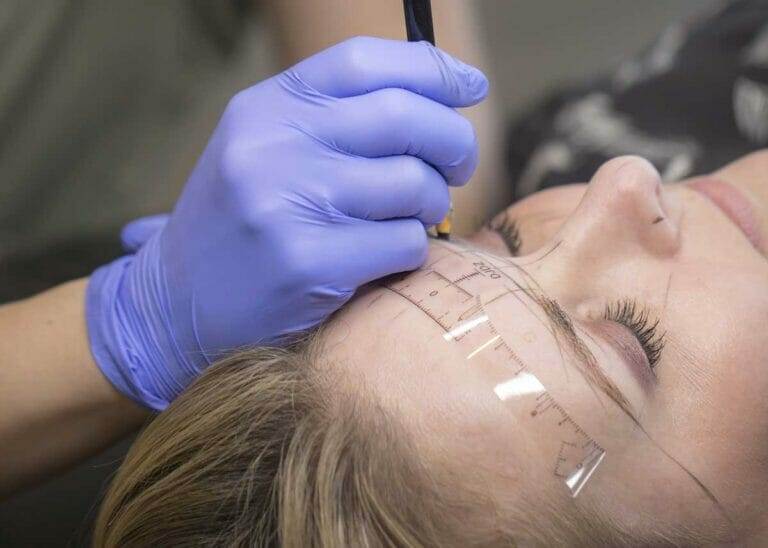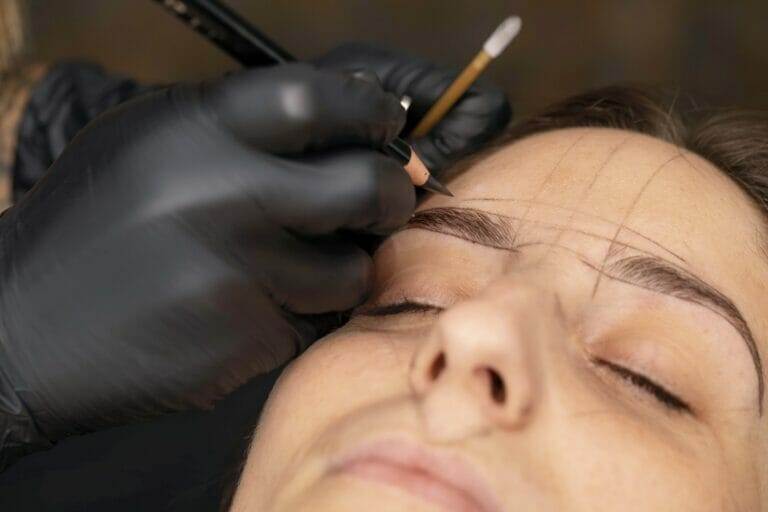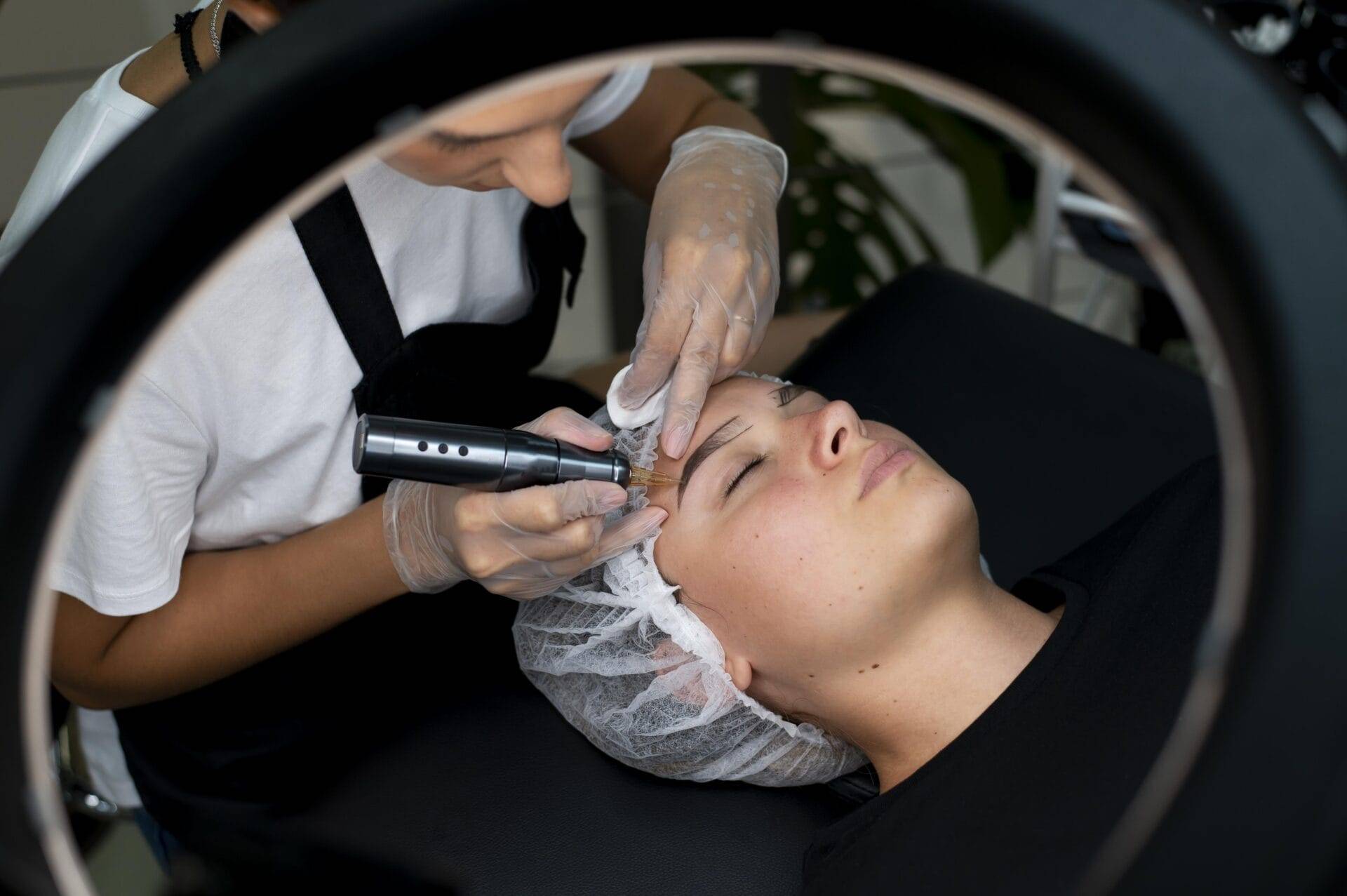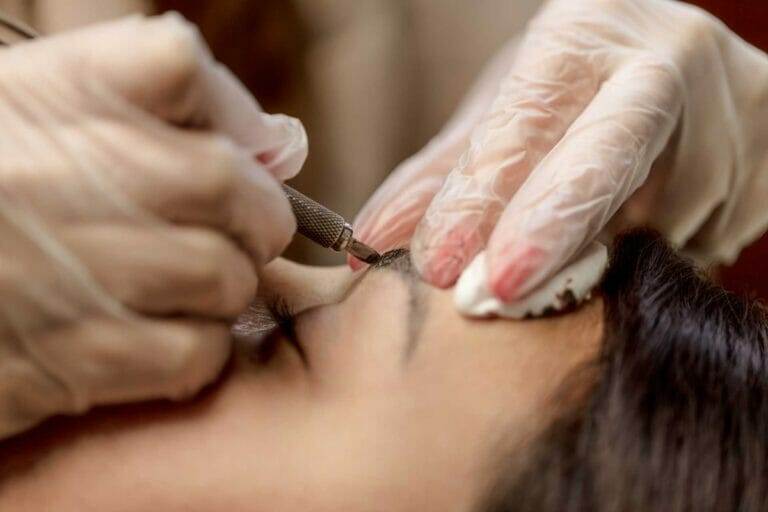Overview of Microblading and Permanent Makeup
Definition and Purpose
Microblading and permanent makeup are innovative beauty techniques designed to enhance one’s appearance and address the common challenges of daily makeup application. Definition:
- Microblading involves the use of a manual, handheld tool to create hair-like strokes on the eyebrow area, giving the illusion of fuller, well-defined eyebrows.
- Permanent Makeup, on the other hand, applies pigment to the skin for features such as eyeliner, lip color, and even blush, serving as a long-lasting alternative to traditional makeup.
Purpose: The primary aim of both techniques is to save time. Imagine waking up and not having to fuss with applying that perfect winged eyeliner or filling in sparse eyebrows every morning! Both methods are particularly beneficial for those with busy lifestyles, allergies to traditional makeup, or physical limitations that make daily applications challenging.

Pros and Cons
While the allure of microblading and permanent makeup is undeniable, it’s essential to weigh the benefits against the potential drawbacks: Pros:
- Convenience: Minimal daily makeup routine.
- Time-Saving: Spend less time getting ready each day.
- Consistent Look: Always look polished without the need for reapplication.
Cons:
- Cost: Initial investment can be significant.
- Longevity: Results may fade and require touch-ups.
- Regret Potential: If not done correctly, results can be unsatisfactory.
Ultimately, understanding the definitions and the advantages and disadvantages helps individuals make informed choices about their beauty routines.
Understanding Microblading
Technique and Procedure
Diving deeper into microblading, it’s essential to understand the intricacies of its technique and procedure. Microblading uses a specially designed handheld tool equipped with fine, angled blades. This allows for precise placement of pigment into the skin, mimicking natural hair. Procedure Steps:
- Consultation: This initial step involves discussing desired eyebrow shape, color, and thickness.
- Mapping: The artist meticulously maps out the eyebrow shape using a pencil, ensuring symmetry and desired contours.
- Numbing: A topical anesthetic is applied to minimize discomfort during the procedure.
- Microblading: The artist carefully makes small incisions and deposits pigment into the skin, stroke by stroke.
- Finishing Touches: After the initial procedure, a healing ointment may be applied to aid recovery.
By focusing on detail and artistry, microblading creates stunningly natural results that can last up to 18 months, depending on skin type and aftercare.
Duration and Maintenance
One of the appealing aspects of microblading is its longevity, but it does require some commitment when it comes to maintenance. Duration:
- Results typically last between 12 to 18 months before a touch-up is necessary.
- Factors influencing longevity include skin type, sun exposure, and overall skincare routine.
Maintenance Tips:
- Avoid Water: Keeping brows dry for the first week is crucial to avoid fading.
- Sun Protection: Use sunscreen on the brow area to prevent pigment breakdown.
- Hydration: Moisturizing can aid in healing but avoid heavy creams directly on the brows.
Understanding the procedure and maintenance of microblading empowers individuals to make informed decisions and better prepare for what lies ahead post-treatment.
Exploring Permanent Makeup
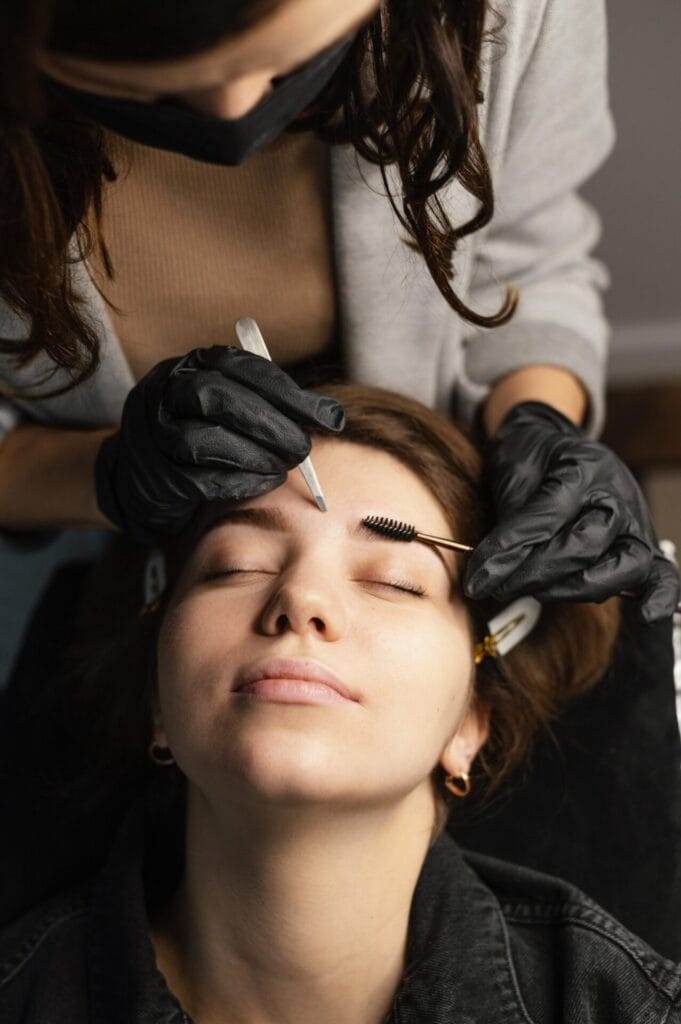
Application Process
Continuing from the insights gained about microblading, it’s essential to explore permanent makeup, which encompasses a broader range of cosmetic applications. The application process for permanent makeup typically covers areas such as eyeliner, lip color, and blush. Step-by-Step Process:
- Consultation: Just like with microblading, the journey begins with a detailed consultation to discuss desired outcomes and color preferences.
- Design and Approval: Artists will often use a pencil to outline the desired shape, allowing clients to visualize the final look before any pigmentation work begins.
- Numbing: A topical anesthetic is applied to the target areas to reduce discomfort during the procedure.
- Pigmentation Application: Using a specialized machine or tool, pigment is deposited into the skin. The technique may vary depending on the desired effect—be it a soft blush or a more dramatic eyeliner.
- Aftercare Instructions: After completion, clients receive specific guidelines to follow during the healing process to ensure the best results.
Longevity and Touch-ups
The longevity of permanent makeup is one of its main selling points, as it offers ongoing beauty without daily application. However, it’s not entirely permanent. Longevity:
- Typically, results can last anywhere from 3 to 5 years, depending on skin type, lifestyle, and exposure to the sun.
- Over time, the color may fade, making touch-ups essential for maintaining that vibrant look.
Touch-up Considerations:
- Initial Touch-up: Often recommended about 6-8 weeks after the initial application.
- Periodic Maintenance: Clients may need touch-ups every 1-2 years to keep their desired look intact.
Exploring permanent makeup reveals its potential benefits for those looking for long-term solutions in their beauty routine, ultimately delivering convenience and enhanced self-confidence.
Differences in Results
Natural Look vs. Bold Look
As we delve deeper into the world of microblading and permanent makeup, it’s important to understand the differences in the results they provide. One of the most significant distinctions is the overall appearance—whether one prefers a natural look or a bold statement. Natural Look:
- Microblading is often celebrated for its subtlety, offering clients the opportunity to achieve beautifully defined eyebrows without appearing overly done. The hair-like strokes blend seamlessly with existing brow hairs, providing a fuller effect while maintaining a natural aesthetic.
Bold Look:
- In contrast, permanent makeup, particularly applications like eyeliner and lip color, can lean towards a more dramatic appearance. Artists can emphasize features significantly, creating a makeup effect that stands out and draws attention.
Ultimately, the choice between a natural or bold look depends on personal style and preference. Clients should communicate their desired outcomes clearly during consultations to ensure satisfaction with the final result.
Pigment Retention and Fading Differences
Another crucial aspect to consider when it comes to results is how pigment retention and fading varies between these two techniques. Pigment Retention:
- Microblading pigments tend to be less intense, allowing for a soft, natural finish. Over time, some clients may find that their brows fade more than expected, necessitating routine touch-ups.
- Permanent makeup pigments, conversely, are often formulated to provide deeper and longer-lasting color. However, this can sometimes leave a bolder impression, which might not appeal to everyone.
Fading Differences:
- The fading process also differs: microblading may fade unevenly, creating a patchy appearance if not properly maintained.
- Permanent makeup, while initially striking, may lose vibrancy over time but can maintain a more uniform coloration.
Understanding the differences in results will enable individuals to make informed decisions about their aesthetic desires, ensuring they choose the right technique for their lifestyle and preferences.
Safety and Risks
Health Considerations
As individuals explore the options of microblading and permanent makeup, it’s crucial to also consider the safety and health implications associated with these beauty procedures. Although many people benefit significantly from these techniques, various health considerations should be kept in mind to ensure a successful experience. Key Considerations:
- Skin Sensitivity: Those with sensitive skin, eczema, or psoriasis may want to consult a dermatologist beforehand. These conditions can complicate healing and affect the final results.
- Allergies: It’s essential to disclose any allergies to pigments or numbing agents during the consultation.
- Medical Conditions: Certain medical conditions, such as diabetes or autoimmune disorders, may impact healing. Always inform the artist about your medical history prior to the procedure.
Ensuring you are in good health will not only optimize results but also reduce the risk of complications later on.
Potential Complications
Like any beauty procedure, microblading and permanent makeup come with their share of potential complications. Common Complications:
- Infection: As with any skin procedure, there is a risk of infection if proper aftercare is not followed. This is why following the artist’s care instructions is critically important.
- Allergic Reactions: Some individuals may experience allergic reactions to the pigments or topical anesthetics used during the application. It can be helpful to ask for a patch test if you’re concerned.
- Uneven Results: Results can sometimes be inconsistent, particularly if the artist lacks experience. This can lead to uneven brows or asymmetrical eyeliner, which may require further corrections.
Being aware of both health considerations and potential complications can help clients take the necessary precautions and better prepare for a rewarding experience with microblading or permanent makeup. Proper research and consultation can mitigate these risks and lead to beautiful results.
Cost Comparison
Initial Investment
As individuals contemplate whether to invest in microblading or permanent makeup, a critical factor to consider is the cost involved. The initial investment can vary greatly depending on the service, the artist’s experience, and geographical location. Cost Breakdown:
- Microblading: This procedure typically ranges from $300 to $800, depending on the skill level of the artist and the complexity of the design. A consultation fee may be added as well.
- Permanent Makeup: For services such as eyeliner and lip color, prices can range from $400 to upwards of $1,500. The intricacy of the placement and technique also plays a role in determining the price.
While this initial investment may seem steep, many clients find value in the time and effort saved in their daily beauty routine.
Long-term Expenses
Though the upfront costs can be significant, it’s essential to consider long-term maintenance expenses in your decision-making process. Ongoing Costs:
- Touch-ups: Both microblading and permanent makeup require touch-ups to maintain their appearance. These typically range from $100 to $300, depending on the procedure and time elapsed since the initial application.
- Aftercare Products: Clients may need to purchase specialized products to support the healing process, which can add to overall expenses.
- Additional Procedures: If the results fade unevenly or if style preferences change, individuals might need to invest in additional correctional procedures.
When evaluating costs, remember that while the initial investment can be high, the long-term savings on makeup application and daily grooming time can offset these expenses. A comprehensive understanding of both initial and ongoing costs can significantly influence one’s choice, leading to a satisfying and worthwhile investment in personal beauty.
Choosing the Right Option
Factors to Consider
As individuals weigh the benefits of microblading versus permanent makeup, it’s essential to consider several key factors that can influence their decision. Each individual’s unique preferences and lifestyle play a significant role in determining the right choice. Key Factors to Evaluate:
- Personal Aesthetic: Determine whether you prefer a more natural look, which microblading offers, or a bolder statement seen in permanent makeup applications.
- Maintenance Commitment: Consider how much effort you’re willing to put into maintaining your results. Microblading generally requires more frequent touch-ups, while permanent makeup may last longer with fewer maintenance needs.
- Skin Type and Sensitivity: Individuals with sensitive skin may respond differently to each procedure. It’s wise to consider how your skin might react and consult with professionals regarding suitability.
- Budget: Factor in both initial and long-term costs—this can help you align your options with your financial goals.
Taking the time to reflect on these considerations will ensure a more satisfying outcome in the long run.
Consultation and Decision-making
Once you have a clear understanding of the factors to consider, the next step involves engaging in a thorough consultation with a reputable artist. This opportunity allows for open dialogue and will aid in your decision-making process. What to Discuss:
- Desired Outcomes: Clearly express your beauty goals and personal preferences to your artist. Bring reference images to help convey your vision effectively.
- Procedure Details: Understand the specifics of each service, including techniques, healing processes, and aftercare.
- Artist Experience: Ask about the artist’s qualifications, portfolio, and client reviews. Feeling comfortable and assured in your provider’s capabilities will help ease any apprehensions.
Ultimately, informed decision-making based on careful consideration and thorough consultations will pave the way for a positive experience with either microblading or permanent makeup, ensuring that you leave the session feeling confident and beautiful.
Aftercare and Maintenance

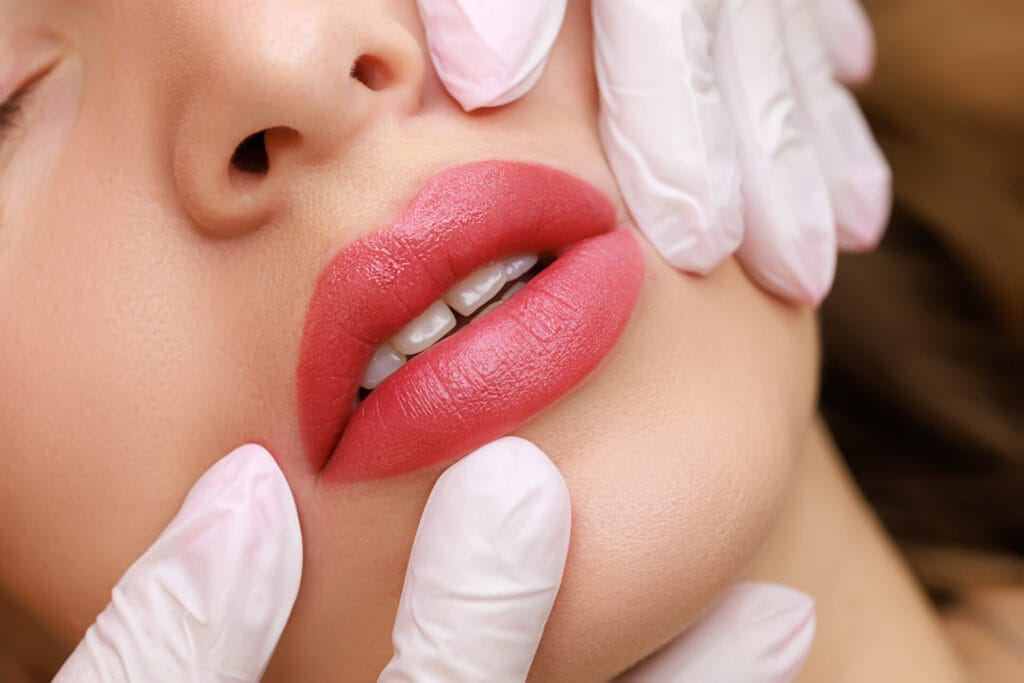

Proper Healing Process
Following the application of microblading or permanent makeup, the aftercare process is crucial for achieving optimal results. Proper healing can significantly impact the longevity and appearance of your new look, so taking care during this phase is paramount. Healing Guidelines:
- Keep It Clean: For the first few days, gently cleanse the area with a mild soap. Avoid using harsh facial cleansers or scrubbing the area.
- Avoid Water: Try to keep your brows or lips dry for the first week. This includes avoiding swimming pools, saunas, and long showers.
- Moisturize: Your artist will likely recommend a specific healing balm. Apply it as directed to prevent excessive dryness and support healing.
- Avoid Makeup: Steer clear of any makeup products on the newly treated area for a minimum of one week. This helps prevent irritation and promotes optimal healing.
Adhering to these guidelines can mean the difference between a flawless appearance and unintentional results.
Tips for Prolonging Results
Once the healing process is complete, there are several strategies to prolong the longevity of your microblading or permanent makeup. Maintenance Tips:
- Sun Protection: UV exposure can cause pigments to fade. Use a broad-spectrum sunscreen on the affected areas whenever you’re in the sun.
- Hydration: Keep your skin hydrated. However, avoid oily products that might disrupt the pigment.
- Regular Touch-ups: Schedule maintenance appointments as recommended by your artist. Most professionals advise a touch-up every 1-2 years to keep the appearance fresh.
- Avoid Skin Treatments: Procedures like chemical peels, laser treatments, and excessive exfoliation can affect pigment longevity. Discuss any skin treatment plans with your aesthetician before proceeding.
By following these aftercare steps and maintenance tips, you can enjoy the beautiful results of microblading or permanent makeup for an extended period, allowing you to look your best with minimal effort.

